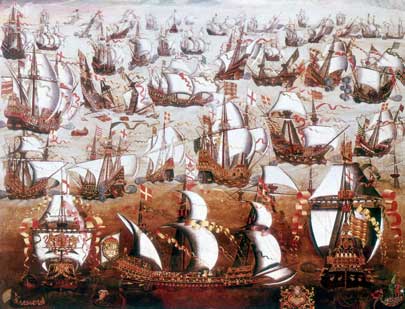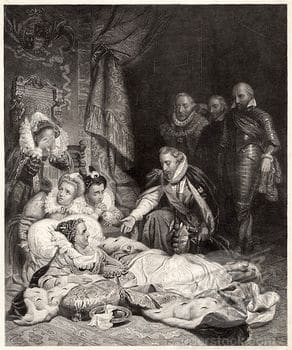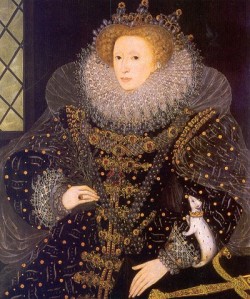Queen Elizabeth was born on September 7th 1533. She was queen regnant of England and Ireland until the 17th of November 1588 until the day of her death. She is the daughter of King Henry VVI and was born naturally into the royal succession.
Her mother who is Anne Boleyn had been executed when Elizabeth was just shy of three years old. There are many reasons as to why they think Anne was executed. Such as she had committed treason, she was accused of incest and adultery, Henry had fallen in love with another woman by the name of Jane Seymour and wanted rid of Anne.
There are many reasons. Elizabeth had an older-half sister named Mary Tudor who is the daughter of King Henry by his first wife Katharine of Argon and a younger half-brother named Edward VI who is the son of Henry by his third wife Jane Seymour.
Elizabeth’s half brother Edward had ruled as king until his death in the year 1553, whereupon he passed the crown up to his cousin Lady Jane Grey, cutting his own two half-sisters. But later on, his will was set aside, and Lady Jane Grey and her husband were imprisoned for treason by Mary I in November 1553, and they were sentenced to death and executed on February 12th, 1554.
Jane had been the ‘nine days queen’. Then in 1558, Elizabeth had succeeded her own half-sister, during whose time in power had been imprisoned for nearly a year on suspicion of supporting Protestant rebels.
During her time in power, Elizabeth depended greatly on a group of very trusted mentors led by William Cecil (Lord Burghley). As Queen, one of her first moves was the establishment of an English Protestant Church, of which she had become the Supreme Governor of that Church. The Elizabeth Religious Settlement later then developed into today’s Church of England.
As Elizabeth grew older, she became very famous for her virginity because she was never married. She felt as if she was married to England and England only. If she had married a man, she would have to follow his orders and Elizabeth did not want that. But she was rather very flirtatious with men to overpower them.

During the Elizabethan Era, the monarch of England was Queen Elizabeth I. The monarch was the ultimate decider and was allowed to determine troubles of national religion, when Parliament would sit and what it would be that it discusses, when the country would or even go to war, education matters, the welfare of citizens, what clothes they could wear and what food they could eat.
Elizabeth had numerous counselors to aid her rule. She would choose the person who would help her govern. Although she could not pass laws by herself, she had to draw up a Bill then forward it to Parliament.
But she was allowed to make Royal Proclamations without Parliament’s say. Sir William Cecil (named Lord Burghley in 1571) had been her chief adviser and had supervised the whole administration.
Queen Elizabeth had many great accomplishments. She proved that women could rule as good as any other man. She survived in a world that was male dominated. She encouraged overseas exploration. She defeated the most powerful man in the world at the time, King Phillip II of Spain when he sent his Armada against the country in summer of 1588.
She successfully managed to lead her people into war. The defeat of the Armada was Elizabeth’s finest hour, and it has gone down in history as one of England’s greatest victories at sea. She also encouraged trade in London and also the Arts and Literature of William Shakespeare. Elizabeth had also helped the poor.

The Revolution of 1559 (Elizabethan Settlement of Religion) occurred after she had walked into power. She thought of a middle way to unite the religious divides that were created by Henry VIII, Edward VI, Mary I. This revolution contained a middle way solution to the Catholicism and Protestantism.
She worked very hard to make her people happy and satisfied religion-based. Earlier, the Act of Supremacy 1558 occurred. This act helps gives Elizabeth complete control of the reigns of the Church of England. Under the rule of Elizabeth, she was given the position and title of the ‘Supreme Governor of the Church of England’. This act also included the oath of loyalty to the Queen.
That means all the clergy had to take this oath or lose their office. The Act of Uniformity 1558 was most important in the Elizabethan Settlement of Religion. This act helped in establishing rules of worship. All of the prayer books of her half-brother Edward were integrated into one book.
This prayer book was to be used by every church under the rule of Elizabeth. It was also made compulsory for all to attend church on Holydays and Sundays. Those who avoided going to church were fined 12 pence.
On October 10th, 1562, 29 year old Elizabeth was taken at Hampton Court Palace with symptoms of what seemed like a bad cold. However, the cold developed and Queen Elizabeth fell seriously ill with a case of smallpox and it was thought that she was going to die. Fortunately, she survived and was not too badly scarred but Lady Mary Sidney – who had nursed Elizabeth back to health, contracted the disease and was severely disfigured.
Her mottos are what she is also very famous for. ‘Video et Taceo’ is one of her most famous quotes which means ‘I see all and remain silent’. This was her way of saying ‘Yes, I know what is going on, but I am not going to make a final decision until I have thought it all through’.
In March of 1603, it was clear that Elizabeth was unwell and depressed, she had retired into one of her favorite homes which was Richmond Palace. She was very stubborn and didn’t let the doctors examine her and she refused bed rest. She stood for hours, occasionally sitting in a chair. Her condition worsened and her ladies-in-waiting spread pillows across the floor for her to rest on and she lay down.
She lay on the cushion-covered ground for nearly 4 days, mostly in complete silence. Soon Elizabeth had grown so weak that when her ladies-in-waiting pleaded and insisted she rest in bed, Elizabeth didn’t argue.
They knew her death was approaching and old Archbishop Whitgift was called to her bedside to say final prayers. She was tended by her ladies-in-waiting and she fell into a deep sleep and never awoke. Her death was described as ‘mildly like a lamb, easily like a ripe apple from a tree’.


who is the author of this source